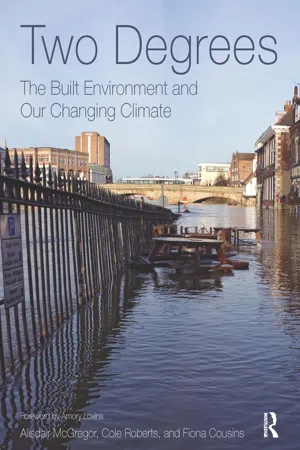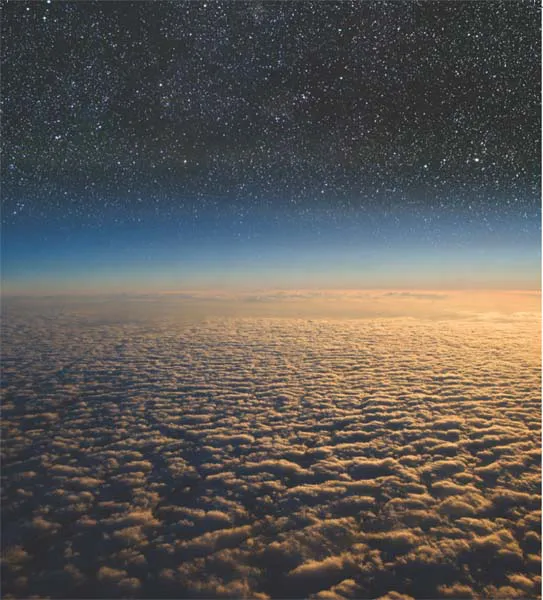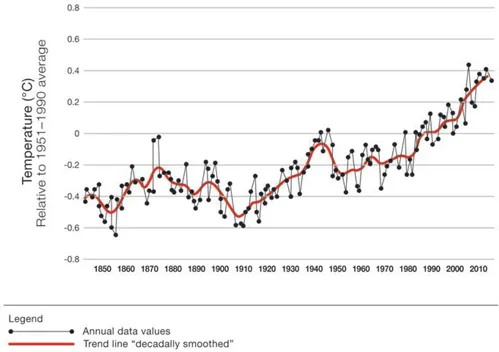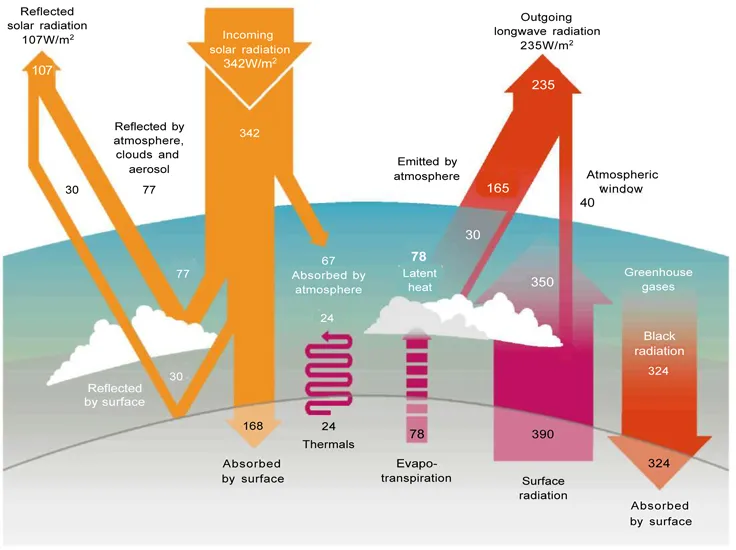![]()
PART 1
Fundamentals
![]()
A view of our atmosphere at high altitude.
From up here, it looks fine. Can we keep it that way?
Image: MarcelClemens/Shutterstock.com
1
REVIEW CHAPTER
The Science of Climate Change
Jake Hacker and Cole Roberts
There are in fact two things, science and opinion; the former begets knowledge, the latter ignorance.
Hippocrates (460–377 BCE)
Since the mid-nineteenth century, the Earth's average surface temperature1 has increased by around 0.8°C (1.4°F) (Figure 1.1).2 Most of this warming has occurred over the last three decades, with the last decade being the warmest decade and 2010 the warmest year since 1850, the start of the global instrumental temperature record.3 The heat content of the oceans has also increased, and there have been other changes directly associated with a warmer world, notably a retreat of land glaciers and a reduction in the extent of sea ice.4 These trends are now viewed to be irrefutable, and although there are some regional variations, the whole globe is getting, on average, steadily warmer. This is the phenomenon of global warming. There have been other changes that can also be attributed to a warming world, such as changes in rainfall patterns, sea-level rise, and an increase in the frequency of extreme climate events. These changes fall under the broader heading of climate change. The most likely explanation is the impact of human activities on the natural environment, principally a change in the chemical composition of the atmosphere.
The issue of human-made (anthropogenic) climate change can be succinctly described by the following two statements:
- The Earth's average temperature is rising due to an increase in the concentration of greenhouse gases (GHGs) in the atmosphere resulting from human activity, principally the burning of fossil fuels and the clearing of forests.
- If humans continue development based on fossil fuel energy, global warming and associated climate changes will accelerate, with dangerous consequences for both the human and natural world.
The two parts of the hypothesis are both recognized by the national science academies of all the major industrialized nations to be true beyond reasonable doubt.5 Despite this, there is still a widespread lack of acceptance of their validity, and a lack of real action to reduce emissions of GHGs or to manage the consequences of climate change. In this chapter, then, we will treat these statements as only a hypothesis, which we will call the Global Warming Hypothesis (GWH).6 We will present the supporting evidence for the hypothesis and go on to discuss some of the implications.
1.1 Global average land and sea surface temperature from direct thermometer measurements since 1850
Graphic: Arup, Data: Met Office (see note 3)
DEVELOPMENT OF THE GLOBAL WARMING HYPOTHESIS
The GWH is not a new concept. It was first proposed by Nobel laureate Svante Arrhenius at the turn of the twentieth century. Arrhenius was fascinated by the problem of explaining the ice ages. In 1896, he published a paper proposing that past climate changes may have been produced by alterations in atmospheric carbon dioxide (CO2) levels. Through hand calculations and building on earlier work by Fourier, Tyndall, and other nineteenth-century scientific pioneers, he showed that a doubling of atmospheric CO2 could have produced an increase in global average temperature of around 4°C (7°F)—enough to account for an ice age.7
However, Arrhenius's most prescient step came a few years later. He argued that the use of fossil fuels could lead to an increase in atmospheric CO2 and that doubling the concentration would produce global warming of around 5 to 6°C (9 to 11°F). He was not overly concerned by this prospect.8 Indeed, as a resident of Sweden, he offered that the warming would make the world a more amenable place for humans to live.
The GWH was recast in a more ominous form in the late 1950s, by scientists concerned about the accelerating use of fossil fuels. Even then, most scientists thought the CO2 released into the atmosphere would be absorbed into the Earth's natural stores of carbon—the world's forests and oceans—but in 1957 two prominent U.S. climate scientists, Roger Revelle and Hans Suess, published a paper showing that the CO2 produced from burning fossil fuels was building up in the atmosphere and that the oceans had much less capacity to absorb CO2 than previously thought.9 These findings started the modern investigation of the GWH, involving a combination of measurement and theoretical investigations. The emerging findings caused the Geneva World Climate Conference in 1979 to conclude: “It is highly credible that a doubling of CO2 in the atmosphere will bring 1.5–4.5°C [2.7–8.1°F] global warming.”10
After thirty years of further investigation, this range of possible temperature change for a doubling of atmospheric CO2 has remained largely unchanged. However, there has been a significant amount of effort to refine the calculations and to reduce uncertainty. In 1979, two major areas of uncertainty remained: first, there was not yet a firm observational confirmation of a global warming trend, and second, while the physical effects of changes in atmospheric CO2 on climate were well understood, other factors that can also influence climate were more uncertain.
FACTORS THAT DETERMINE CLIMATE
Climate is time-averaged weather. The factors that determine day-to-day weather are complex and, as you know if you've ever been frustrated by the weather forecast, evidently difficult to predict. However, the factors affecting climate are stable and easy to understand.
The temperature of a planet's surface is determined primarily by two factors: the amount of sunlight that reaches the surface and the rate at which heat is radiated away from the surface into space. A crucial aspect of the physics of climate change is that the thermal radiation carrying these two heat flows occurs at different wavelengths in the electromagnetic spectrum. This is because the surfaces of the Sun and the Earth are at very different temperatures. The Sun produces shortwave radiation in the visible and near-visible parts of the spectrum, whereas the Earth produces longwave infrared radiation. In thermal equilibrium, the two heat flows are equal. The warmer the Earth is, the more infrared radiation it produces, so equilibrium is reached when the Earth's surface is at just the right temperature to balance the shortwave radiation received from the Sun. Another way to think about this is that the Earth's atmosphere is like the inside of a building built of glass (e.g., a greenhouse). The atmosphere is the glass; the land and oceans are the floor; the near-surface air temperature is the air temperature in the building (Table 1.1).
TABLE 1.1
Analogy between the Earth's climate and a room heated only by the Sun
Data: J. N. Hacker, “Climate as a Driver of Change: Part 1: The Evidence and the Causes,” Arup Journal, 2007, 1.
Earth climate | Room climate |
Sun | Sun |
temperature of lower atmosphere/Earth's surface | room air temperature |
greenhouse effect | insulation |
sea and land ice | reflective blind |
clouds | curtains |
ocean | thermal mass of building fabric |
1.2 The Earth's radiation balance
Graphic: Arup, adapted from Kiehl and Trenberth, 1997i
The amount of sunlight reaching the surface is determined by the Earth's “shading”: the reflection of sunlight from the tops of clouds and from snow and ice. About 30 percent of the Sun's radiation is reflected directly back into space, 25 percent from clouds and 5 percent from ice (Figure 1.2). Shading is also provided by atmospheric aerosols—fine particles such as smoke, fog, and mist. Aerosols have natural sources, such as volcanoes, but there are also anthropogenic sources, principally from burning biomass and fossil fuels. Light-colored aerosols reflect sunlight, so they have a cooling effect, but dark-colored aerosols, such as soot, absorb sunlight, so they have a warming effect. Aerosols also promote cloud formation, which increases shading, so they have an indirect cooling effect.
The Earth's “insulation” is the atmosphere. The atmosphere is largely transparent to shortwave radiation but mostly opaque to infrared radiation because of the GHGs it contains, which effectively reflect some of the longwave radiation back toward the Earth's surface (Figure 1.2). This means that the Earth must produce more radiation—i.e., get warmer—to transmit the same net radiation through the atmosphere out into space. Without the GHGs, the Earth's surface would be around 33°C (59°F) cooler (Table 1.2). This...



